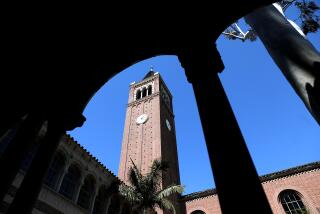In Community College Trenches, Reforms Ignore Reality
- Share via
I think that I have finally figured out why the current efforts to “reform” our community colleges don’t square with the needs that I see every day at work. And maybe what I’ve figured out also helps explain why education, even though reformed every couple of decades, doesn’t seem to stay reformed.
Two reports--one by a commission of citizens and the other by a committee of legislators--represent the latest attempts to update California’s Master Plan for Higher Education. Both say about the same thing. And now these reports are being converted into legislative bills and ultimately state law.
In their introductory sections, the reports speak of the need for great commitment by all if we are to cope with the massive social, economic and demographic changes that are on the verge of creating a convulsion in California. But the reader seeks in vain for statements that convert commitment into actions.
This is what we in the trenches have become accustomed to in recent years. It seems that the complex problems facing California are so overwhelming that politicians who are more concerned about the next election than working for the long-term common good will never provide us with anything but Band-Aids.
These reform proposals provide few tools, money or practical action plans. Those actions that are recommended--such as testing of all incoming community college students--lack congruence and horse sense, and do not mesh with the real needs of the state so eloquently outlined in the proposals’ introductions.
Testing of all incoming students is one reform that I have seen come by twice. The alleged purpose is to more accurately place students in appropriate classes. This flies in the face of research that, except in very limited cases, fails to demonstrate how any test can predict with assurance that a given student will be successful in a given class. Each time in the past when standardized tests were looked to with unrealistic expectations, the result was disappointment rather than better student success.
Another recommendation that seems to be out of joint with the world described in these reform reports relates to the new mission recommended for community colleges. Did anyone writing these reports bother to find out who attends California’s community colleges?
We are told that our primary job is to prepare students to transfer to four-year colleges or to enter the work force. For those students who have such objectives, we already do these things quite well. However, most of our students need quick retraining because they have been thrown out of work, or they need to learn to read, write and compute.
We in the community colleges don’t like to admit it, but our major task now should be to improve literacy. Between 1980 and 1984, the number of students in the Long Beach Unified School District with limited English skills increased by just under 50%.
The best research available on California community college students (the Statewide Longitudinal Study, 1978-1981) was never referenced in the reports. Yet this study both described our students in detail and tracked them after leaving us. It showed clearly that the mission that the reformers would have us perform does not relate to most of our students. Aside from the majority who need some kind of special survival skills, we have other large groups of students interested in things other than going to a four-year college or pursuing a vocational skill. Over 10% already have college degrees and are probably attending simply to improve their minds. And at least 15% are just trying to decide what they want to do when they grow up.
We in the community colleges currently labor under 2,200 separate state statutes and each year we face about 250 new laws introduced by state legislators to “help” us. Few of the statutes and bills recognize the kinds of students we serve or help us to serve them. And fewer bills still take into consideration the major social and economic issues about to convulse this state. All too often, reforms turn out to be prescriptions for increasing the education bureaucracy. And such prescriptions do not begin to deal with such issues as the ticking time bomb of steadily declining literacy.
Reforms, when they are calls for action with little relationship to reality, can only die stillborn. In addition, academic reforms never take hold, or last, when imposed from outside. This truism will be demonstrated in a few years when the “reform” craze is over.
The real problem here is that the state is trying in vain to solve local community problems. The Legislature and the governor cannot solve local problems effectively.
I think that few Californians realize what they really did when they voted for Proposition 13 in 1978: They really voted for state control of their local institutions. Before it is too late, we need some leaders with the vision and will to find mechanisms for returning local control to the people.
More to Read
Sign up for Essential California
The most important California stories and recommendations in your inbox every morning.
You may occasionally receive promotional content from the Los Angeles Times.










